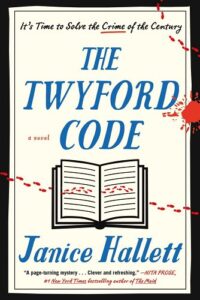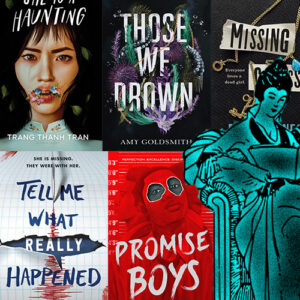In my latest novel The Twyford Code, a former prisoner navigates life on the outside while revisiting a traumatic childhood event. Motivated by the need to understand what happened when his teacher disappeared on a school trip, Steve’s quest is complicated because he has only just learned to read and still can’t write. All we have to go on are transcriptions of the voice-recordings he has to make on an old iPhone to keep track of his investigation.
Despite its unusual narrative format, The Twyford Code is not unusual in taking the experience of a prisoner or former prisoner as its narrative drive. In fact, while prison may be the end of the road for a murderer in the traditional crime novel, as the following books show, it can also be the beginning of a whole new story…
Incarceration is meant to be about redemption so where better to start than the definitive 20th Century prison novel that states its case right there in the title: The Shawshank Redemption by Stephen King. Andy Dufresne is imprisoned for the murder of his wife and her lover. It takes him the entire book and 19 years of a double life sentence to discover the real culprit and bring them to justice. The ingenuity and fortitude of the main character as he is broken by prison life has us cheering him on in his quest to prove his innocence – and escape.
Escape is an emotive, yet delicate concept. Don’t we all long to escape metaphorical prisons of one sort or another? Reading is itself a form of escape… But only under certain circumstances do we cheer for a prisoner attempting to evade his redemption – for instance, we must know them to be innocent as charged and fundamentally a ‘good’ character. Papillon by Henri Charriere tells the ‘true’ story of the author’s imprisonment for life – wrongly he claimed – in 1930s French Guiana. It’s a famous tale of his – alleged – repeated attempts to abscond from a succession of prisons and penal colonies. In the book, the protagonist’s escape campaign takes on heroic proportions that overshadow his original conviction. Whether the book tells his personal story accurately, or blends his experiences with those of other prisoners he met over the years, is still not fully established.
The innocent prisoner, someone wronged by others and/or the legal system, is a recurring theme in fiction and drama, playing on our deep-seated fears of being accused and convicted of a heinous crime we did not commit, locked away and forgotten about…
Alexandre Dumas’ seminal The Count of Monte Cristo and The Man in the Iron Mask both centre on characters imprisoned for decades following bogus allegations, and in the case of the former, once free going to great lengths to wreak revenge on his jealous accusers.
When it comes to modern crime fiction, a recently-released prisoner intent on clearing their name makes for a highly motivated ‘narrative detective’ – a character with an axe to grind and nothing to lose. In tense and pacy thriller The Guilty Couple by C.L. Taylor, Olivia Sutherland has served five years for a murder she blames on her husband. Utilising all the street smarts she learned inside, and with the help of other former prisoners befriended on the wing, she sets about proving her innocence while struggling to rebuild her shattered relationship with her daughter.
Meanwhile, in Emily Schutz’s dark and menacing Little Threats, the protagonist is unsure herself whether she’s guilty or not. Accused of murdering her best friend, Kennedy Wynn pleads guilty at trial, but 15 years is a long time to mull things over and by her release she wonders if she really was the killer or whether as a vulnerable teen she fell victim to other people’s manipulation. We follow Kennedy on a journey of discovery through her family’s long-buried secrets towards a strong, surprising conclusion.
So how do we feel when a prisoner is guilty as charged, but has served their time? There is still much to be said about the way society treats former offenders. Social stigma defines the released prisoner’s world in fiction as it does in life. Yet there is something fascinating about a character who is as low in society as they can possibly go, perhaps even more so than a high-flyer with a long way to fall. A person with nothing left has nothing to lose, and that makes for a dangerous, unpredictable character. Agatha Christie captured this wildness and desperation in her novel Appointment With Death (caution: spoiler ahead). In this tale Lady Westholme commits murder in order to keep her status as a former prisoner a secret. Bearing in mind she wasn’t previously imprisoned for homicide, the fact she crossed that line just to silence her blackmailer says much about that very desperation.
My first novel The Appeal dealt with a miscarriage of justice, as two law students and their mentor work to release an innocent person from prison. Yet when someone is imprisoned for a crime they obviously didn’t commit, the line between right and wrong is a little too clear cut – it’s easy to be on the side of the innocent party. Sympathy flows less freely toward the guilty, so as a storyteller it can be interesting to play with that sense of righteousness. In The Twyford Code I chose to draw Steve as a flawed character, albeit a compelling one, and whether he is guilty as charged or not, he is far from innocent.
There are many examples in fiction where the reader is invited into the mind or world of a confirmed criminal who, in the case of true crime books, speak from their prison cell. The most famous is Truman Capote’s In Cold Blood. In this classic of the genre, the famous writer struggles to reconcile the knowledge a terrible mass murder was committed by the two apparently vulnerable young men he befriends on Death Row.
Jack Henry Abbott, the author of In the Belly of the Beast was himself a former prisoner, one of the first to write eloquently about his time in the penal system – an insight that did not prevent him committing further terrible crimes and ending his days behind bars. We may ponder the difference between his story and that of Henri Charriere who became a minor local celebrity in Venezuela after being pardoned by the French government. Such was his redemption, Steve McQueen starred in the film of Papillon in 1973.
But a ‘prison’ does not have to be an official establishment. Inspired by a number of shocking real-life cases, a current trend is for crime fiction to explore the experiences of innocent victims imprisoned at the hands of criminals. The classic of this genre The Collector, was a much-lauded debut by John Fowles in 1963. It uses the imprisonment of wealthy art student Miranda by society underdog Frederick to ask questions about class and society, yet it pales in comparison to recent examples.
Emma Donoghue’s fabulous Room is the story of a young woman learning to live on the ‘outside’ after being locked up for seven years by an abductor – it is a wonderful, heart-stopping story told through the eyes of her five-year-old son.
Scheduled for publication in June 2023 is The Quiet Tenant by Clemence Michallon. This impressive debut follows the escape plan of a woman held captive in plain sight by an outwardly respectable serial killer.
The former prisoner will be a compelling character for as long as guilt, shame and redemption continue to drive narrative arcs in fiction – and for as long as escape remains a byword for the thrill and excitement we all secretly crave – and can only find in the pages of a book.
***


















